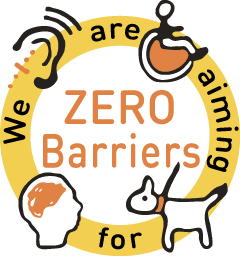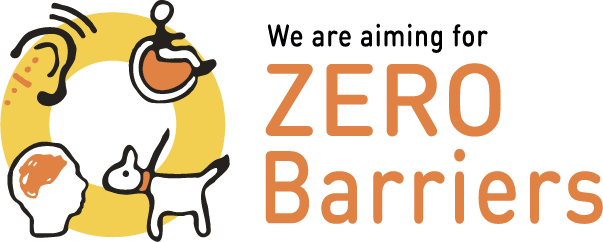
Accessibility Guide
Zero Barriers Accessibility Guide offers simple solutions for business and services to become disability friendly, gain more customers and grow their business.
This guide will provide you with simple, cost-effective solutions to improve customer access and inclusion for people with disability.
RIGHTS AND RESPONSIBILITIES
All staff should be made aware that businesses are subject to the Disability Discrimination Act 1992 (the Act). The Act makes it unlawful to discriminate, in the provision of goods, services or facilities, against people on the basis that they have, or may have, a disability. The Disability Inclusion Act is specific to NSW and commits the NSW Government to promoting inclusion of people with disability, which will enrich community life for everyone.
Find out more HERE
You should allow guide dogs and assistance animals into your premises. These animals are not pets but highly trained support and will help the customer to safely use your business and service.
Assistance animals not only help people who are blind or have low vision, but they can also be used by people who require support for mobility or other functional tasks; people who experience episodic and serious medical crisis (e.g. epilepsy, changes in blood pressure or blood sugar) and people who experience psychosocial disorders.
Find out more HERE
SERVICE (SOCIAL ACCESS AND INCLUSION)
Social access and inclusion is the provision of inclusive service. This means that staff engage with customers with a disability in an inclusive, welcoming and respectful way.
Staff should be offered opportunities for disability awareness training to improve their knowledge and understanding of disability. This can be run by management at your business or service, or through an external training provider. By improving your staff’s awareness of disability, they are better able to provide an inclusive service to their customers and clients with a disability.
There are many resources that can assist your staff in becoming disability aware on this website.
Inclusive service provision
- When approaching a customer, be polite, introduce yourself and ask how you can help
- Talk directly to the person with disability, not to other people who may be with them
- Use clear, simple language and use a friendly tone of voice
- Refer to the person’s disability only if it is critical to what you are trying to communicate
- If a person is deaf or hard of hearing, make sure you face the person when you speak. Have a pen and paper on hand could be helpful
- Don’t shout, use big hand gestures or speak extra slowly to someone who is hard of hearing or has difficulty understanding – just speak clearly
- If a person is blind or has low vision, identity yourself by name to them, ask for their name so you can address them directly and so they know you are talking to them
- Don’t patronise or speak down to a person with disability, and don’t assume they won’t understand you
- Body language is also an important communicator; try to maintain positive, open body language
- Don’t distract a guide or service dog by patting it or giving it food.
- Ask if the person wants help first before providing assistance
- Be considerate of the extra time it may take some customers to say and do things
- Don’t make assumptions about the disability or disabilities a person has
- Some disabilities are not visible. Take time to get to know the customer’s needs
- Be respectfully accepting of requests or suggestions from customers with disability, such as removing a chair or allowing wheelchair access to a table
- Smile, relax and keep in mind that people with disability have an equal right to good customer service
PREMISES (PHYSICAL ACCESSIBILITY)
There are some considerations and simple adjustments that can be made to your business to reduce physical barriers and increase disability access for your customers. These are not only beneficial to people with disability but also make it easier for other customers in need of assistance, including older people with mobility concerns, parents with prams and those who are in need of assistance.
- Assign a designated parking space/s for people with disability where possible
- Clear the path of travel from parking space to your premises
- Ensure the entrance to your business is accessible; consider installing an automatic door button if possible or install a bell so that staff can open the door for customers with disability when required
- Make available a portable ramp to access your store if necessary
- Remove obstacles and clutter from doorways and aisles that may pose as obstructions or trip hazards; make it safe and easy for customers to access and manoeuvre around your business
- Ensure that if there are steps in your premises, that they are smooth, non-slip and well-lit
- Install handrails and guardrails where necessary, and ensure that door handles are at an accessible height
- Ensure that furniture and fittings do not prevent access
- Provide clear signage that is visible for all facilities in your business
- Ensure floors and surfaces are non-slip and any hazards are clearly marked
- Ensure aisles are wide enough for pram/wheelchair/walking frame access
- Ensure at least part of your service counter is accessible and well-lit
- Ensure an EFTPOS machine is available and accessible
- Provide a seat near the service counter for customers who are waiting
- Ensure that an accessible toilet is available or that your staff is informed about the nearest accessible toilet
COMMUNICATION AND MARKETING
Communication and marketing for your business should be as inclusive and accessible as possible. There are many ways you can improve your communication that are simple, easy and cost-effective.
- Use clear simple language, avoid complex words or jargon – keep text simple and easy to understand
- Ensure that your business can be contacted using a number of different ways including email, phone and SMS
- If your business has a website, ensure your it is built with accessibility in mind
- Familiarise staff with the National Relay Service (relayservice.gov.au)
- Ensure that all signs are clear, easy to read and use high contrast colours
- Where relevant, provide information with relevant pictures and/or visual representations (e.g. menus)
- Use captions on videos where possible
- Keep a pen and paper readily available at the counter for customers to use to communicate with staff
Case Studies in Improving Access and Inclusion
A customer with psychosocial disability that uses an assistance animal trained by a specialised service to alleviate the effects of her disability claimed a security guard denied her access to a shopping centre with her assistance dog because she is not ‘blind’, despite her providing identification information about the assistance dog. The Australian Human Rights Commission advised the shopping centre of the complaint, and it was resolved. The shopping centre and security company assured the customer that she would be welcome to attend the shopping centre with her assistance dog in the future. They also agreed to deliver training to staff based on materials provided by the specialist service that trained the complainant’s dog.
A small fast-food outlet that has a narrow, stepped entrance that cannot be widened addressed this by fitting a low-level bell so that customers who cannot get into the building can ring the bell for service at the door.
A courier service, when refurbishing its premises, replaced the outward opening doors with automatic sliding doors. These save space, are more secure and make their premises disability accessible, including its own parcel carrying employees. It also modified its signage, placing them at eye level to identify possible hazards.
A supermarket developed a website that is accessible to the widest possible range of customers. They wanted their website to be available to customers with low vision, hard of hearing and restricted mobility. As such, they used an easy to read font, tagged images and used consistent navigation.
A shop that recognises that they sometimes require customers to queue provided a seat near their register. This allows customers in need of assistance to sit while they wait to be served, or to rest their purchases at a raised level if lifting is difficult for them.
More Useful Resources for Disability Inclusion
As a Zero Barriers business, we appreciate that you recognise that disability inclusion is a necessary commitment for the betterment of society. Becoming disability inclusive is an ongoing journey and we are here to support you on that journey. We have also included a number of other resources that can assist you. Click on the links to find out more.
A brief guide to the Disability Discrimination Act – HERE
Inclusive Language – HERE
Inclusive communication for people who are blind or with low vision – HERE
Information about Deaf identity, hearing loss and communicating with Auslan – HERE
Learn Auslan – HERE
Information about the National Relay Service – HERE
Disability access symbols – HERE
Information and support for employers who employ people with disability –HERE
Access and inclusion Index, for employers – HERE
The Business Case for a Carer-friendly Workplace – HERE
Top 10 Tips for a Carer-friendly Workplace – HERE
What's in it for your business?
Businesses and services that become a part of the Zero Barriers Project can benefit in a number of ways:

Get Approved
Become a part of a recognisable movement by displaying the Zero Barriers Logo on your shopfront and digital Medi/marketing Marterials.

Get Visibility
Improve your visibility by getting included in the Zero Barriers' Business Directory where people can find you among other trusted providers.

Get Informed
Gain access to the Zero Barriers' Accessibility Guide as well as our Monthly Newsletter with details on all the latest industry news and updates.

Get Awarded
Become eligible for nomination for and potentially receive a Zero Barriers Business Excellence Award to instantly boost your business's profile and credibility.








